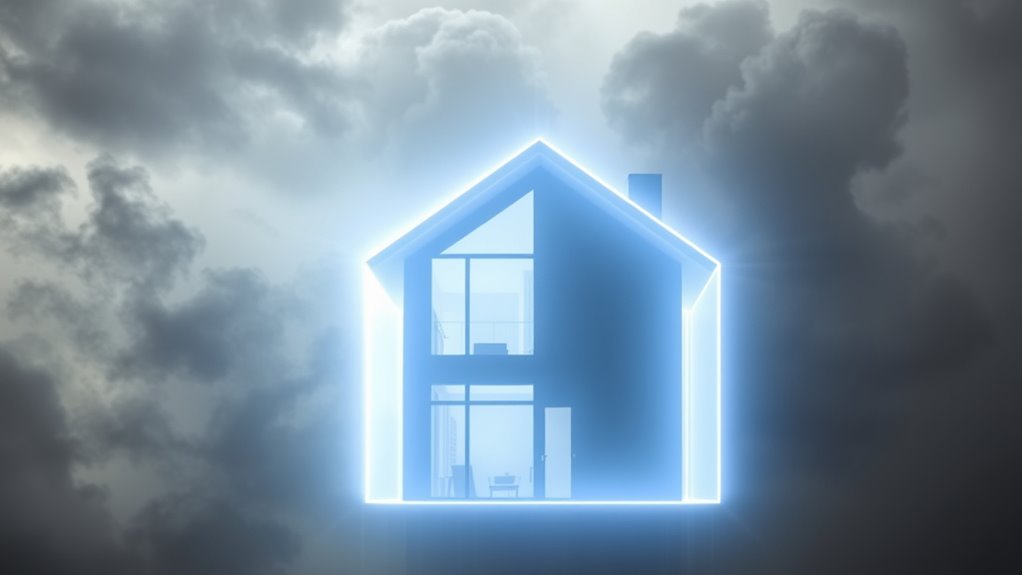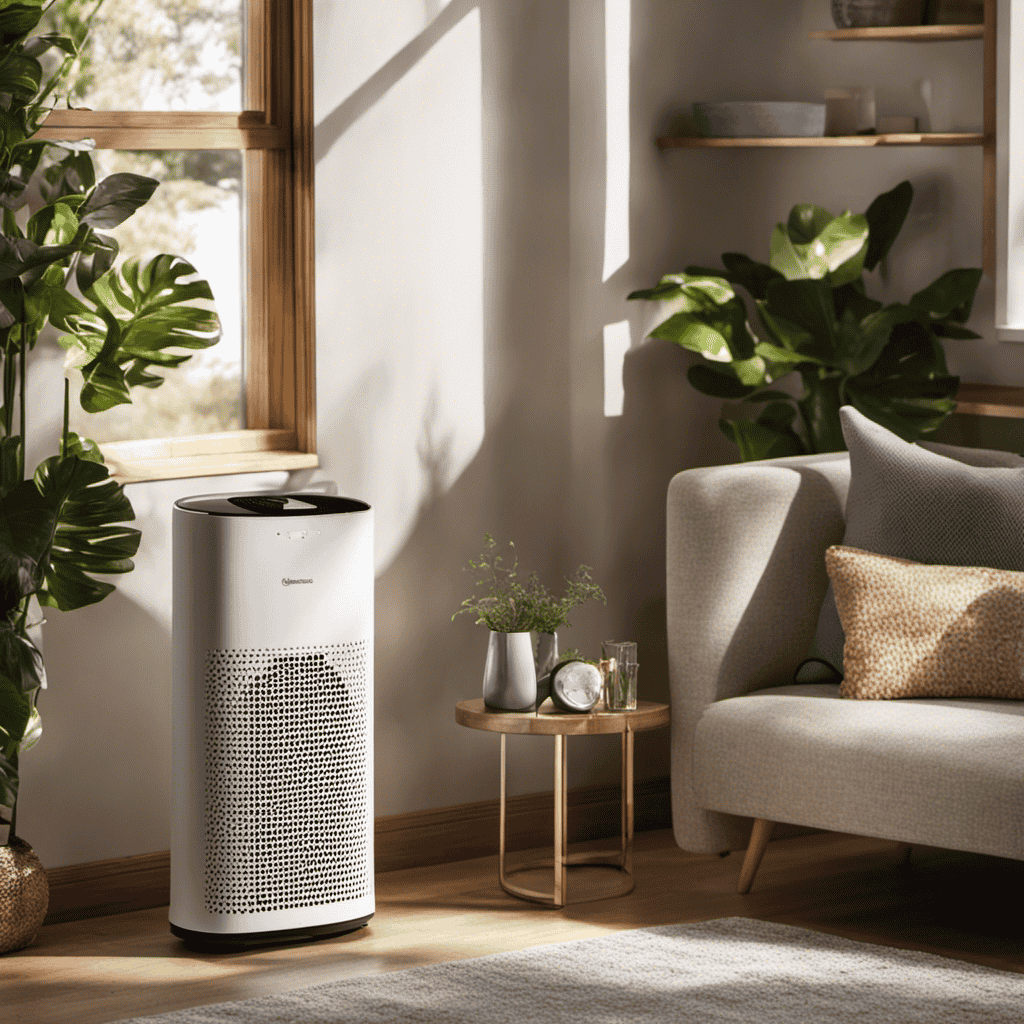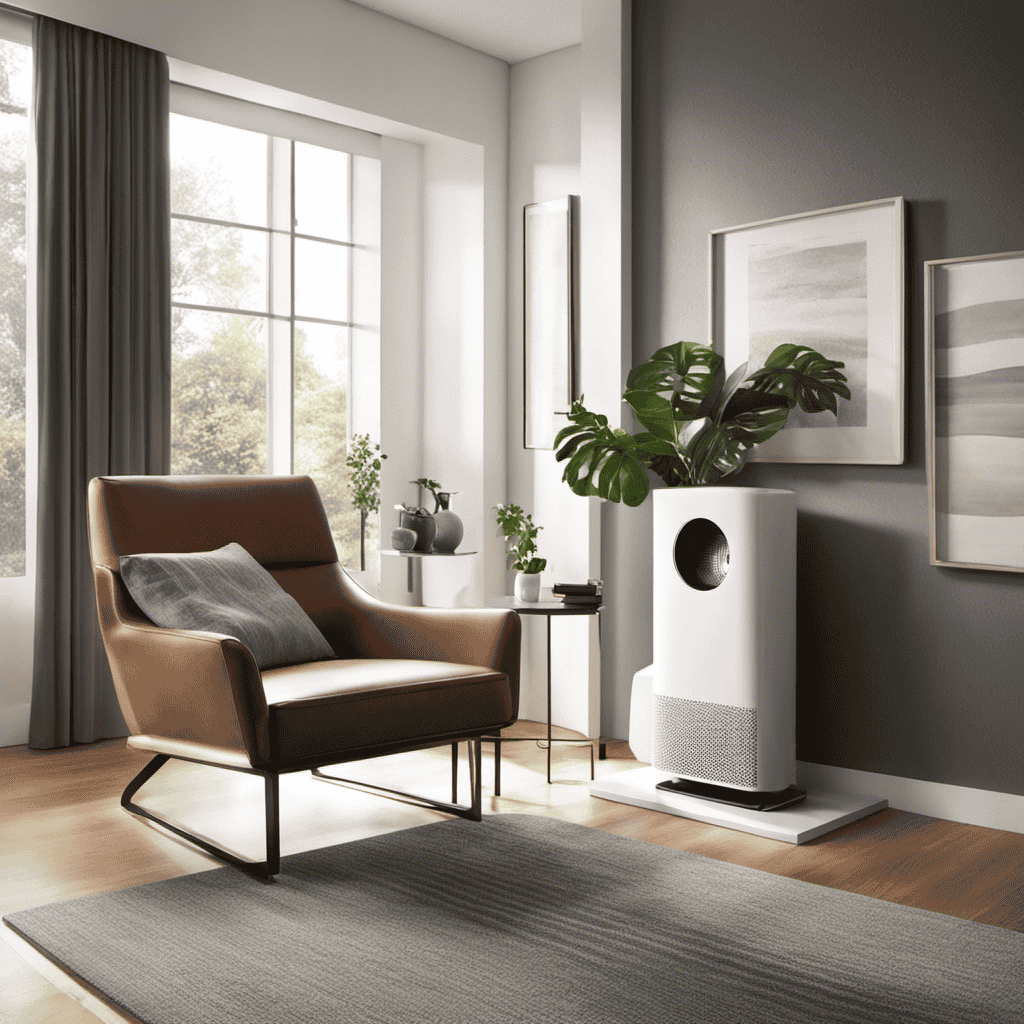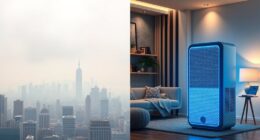To prevent city smog from invading your home, create a positive pressure zone by installing a ventilation system that continuously supplies filtered, fresh air while balancing exhaust points. Seal gaps and cracks to maintain higher indoor pressure, acting like an invisible shield against outdoor pollutants. Regularly service your ventilation system and monitor air quality to keep your indoor environment safe. If you want to learn effective strategies for building and maintaining this barrier, keep exploring these options.
Key Takeaways
- Establish a controlled airflow system that introduces filtered outdoor air to maintain higher indoor pressure.
- Seal gaps, cracks, and poorly sealed windows to prevent smog infiltration through unintended openings.
- Use HEPA or activated carbon filters in ventilation systems to ensure clean, pollutant-free air intake.
- Balance the ventilation by matching intake and exhaust rates to sustain a slight positive pressure.
- Regularly monitor indoor air quality and system performance to ensure the positive pressure zone effectively blocks smog.

City smog poses a serious health threat, but creating positive pressure zones offers a practical solution. When smog infiltrates your home, it can degrade indoor air quality and increase your risk of respiratory issues. To combat this, establishing a positive pressure environment becomes essential. By doing so, you create a barrier that prevents polluted outside air from seeping inside, ensuring you breathe cleaner air. This approach relies on effective ventilation strategies that maintain higher air pressure indoors, pushing potentially contaminated air out rather than pulling it in.
Creating positive pressure zones keeps outdoor smog from entering your home and improves indoor air quality.
The core idea behind positive pressure zones is simple: you introduce more air into your home than you exhaust. This is typically achieved through dedicated ventilation systems equipped with high-quality fans and filters. These systems continuously supply filtered, fresh air into your space, maintaining a steady flow that keeps indoor air pressure higher than that outside. As a result, when a door or window opens, the natural flow of air moves outward, preventing smog-laden air from entering your home. It’s like creating an invisible shield, actively blocking pollutants from invading your living space.
To implement this effectively, you need to focus on your ventilation strategies. First, verify your home has a reliable intake of filtered outdoor air. HEPA filters or activated carbon filters can trap particles and pollutants, substantially improving air quality. Second, it’s crucial to control exhaust points so they don’t create negative pressure zones that could draw in unfiltered air through gaps and cracks. Instead, your exhaust should be balanced with your intake, maintaining a slight positive pressure. This balance ensures that even if windows or doors are briefly opened, the internal airflow still favors the outward movement of indoor air, keeping smog outside.
Another critical aspect is sealing your home properly. Cracks, gaps, and poorly sealed windows undermine your efforts by allowing polluted air to infiltrate. Investing in good insulation and sealing materials helps maintain the positive pressure environment. Additionally, regular maintenance of your ventilation systems ensures ideal performance, preventing the buildup of stale or polluted air inside. Consider installing sensors that monitor air quality and pressure levels, so you can adjust your ventilation strategies as needed and respond swiftly to changes in outdoor air quality. Implementing proper ventilation tactics can significantly enhance your home’s ability to stay protected from city smog.
Creating a positive pressure zone isn’t just about technology; it’s about consistently managing airflow to prioritize your health. When you set up your home with proper ventilation strategies aimed at maintaining higher indoor pressure, you effectively reduce your exposure to city smog. This proactive approach not only improves your air quality but also enhances overall comfort, giving you peace of mind knowing you’re actively protecting yourself and your loved ones from harmful outdoor pollutants.
Frequently Asked Questions
How Does Positive Pressure Prevent City Smog From Entering Homes?
Positive pressure keeps city smog out by ensuring your home’s indoor air pressure stays higher than outside. This pushes contaminated air away from vents and openings. You can achieve this with proper air filtration and ventilation systems that introduce clean, filtered air into your home. As a result, smog is less likely to seep in, creating a healthier, more comfortable environment and reducing indoor pollution.
What Types of Equipment Are Needed to Create a Positive Pressure Zone?
You might find it surprising, but creating a positive pressure zone requires specific equipment. You’ll need robust ventilation systems to introduce clean air consistently. Additionally, air filtration devices are essential to remove pollutants before air enters the space. Together, these systems work to maintain higher indoor pressure, preventing outdoor smog from infiltrating. Properly installed, this setup keeps your home safer and healthier by continuously pushing out contaminated air.
Can Positive Pressure Zones Be Implemented in Existing Homes Easily?
Implementing positive pressure zones in existing homes can be doable with DIY installation, but it depends on your home’s setup. You’ll need to take into account cost considerations, such as equipment and potential modifications. While some systems are straightforward to install yourself, others might require professional help. Assess your home’s size and ventilation needs to determine if a DIY approach makes sense or if investing in professional installation is better for a reliable, effective positive pressure zone.
Are There Any Health Risks Associated With Positive Pressure Systems?
Think of positive pressure systems as your home’s shield, preventing outdoor pollutants from sneaking in. Generally, they improve indoor air quality and ventilation systems. However, if not properly balanced, they could cause issues like moisture buildup or pushing allergens further into your home. While health risks are minimal with correct installation, it’s wise to consult professionals to guarantee your positive pressure zone remains a safe, effective barrier against pollutants.
How Effective Are Positive Pressure Zones During High Pollution Days?
During high pollution days, positive pressure zones can markedly improve air quality inside your home. They work by boosting ventilation effectiveness, preventing outdoor smog from infiltrating. You notice fresher air and fewer pollutants indoors, making your environment healthier. While no system is perfect, properly maintained positive pressure zones are quite effective at reducing pollutant levels, giving you peace of mind and a safer indoor space during days of high external pollution.
Conclusion
Creating a positive pressure zone can effectively keep city smog out of your home. By maintaining a steady flow of filtered air, you reduce indoor pollution and breathe easier. Did you know that indoor air can be up to five times more polluted than outdoor air? This statistic highlights the importance of such measures, especially in urban areas. Take control of your environment—invest in positive pressure solutions and enjoy cleaner, healthier indoor air every day.










